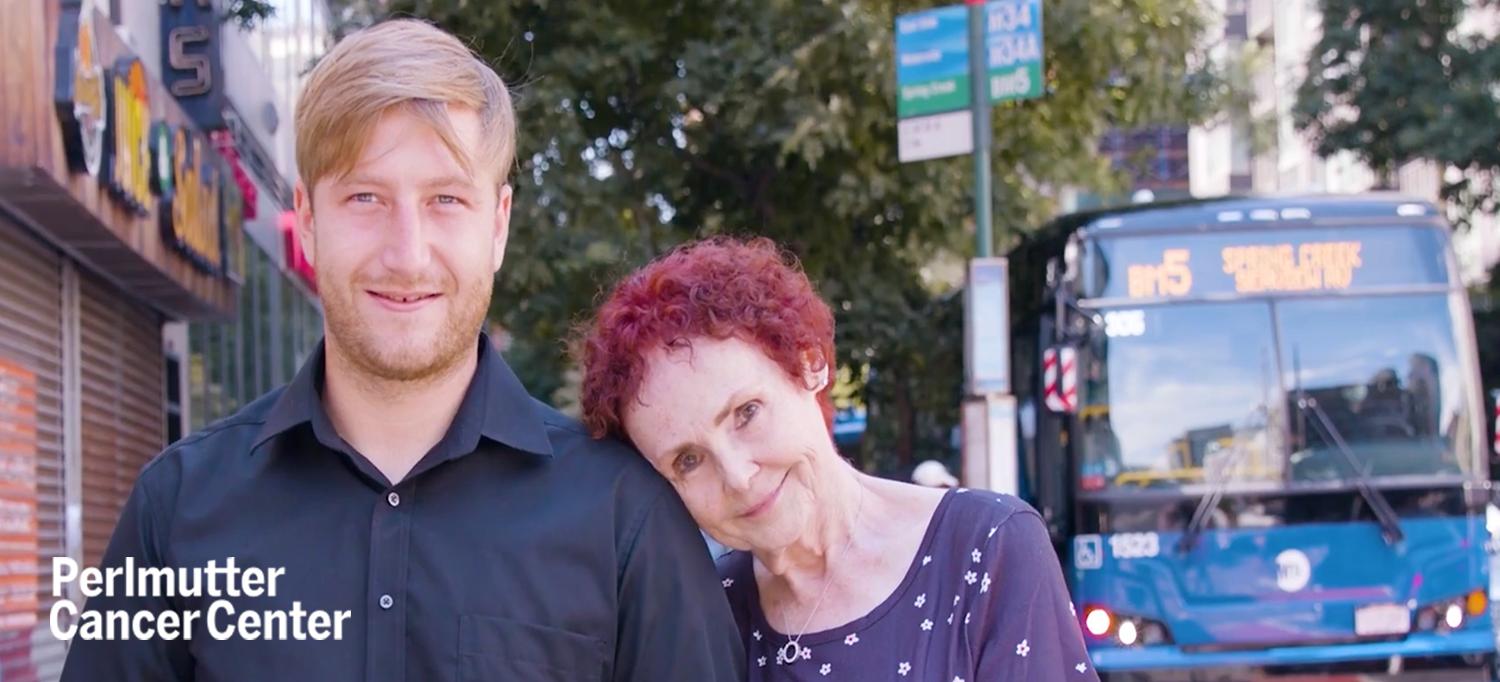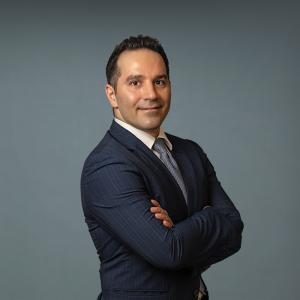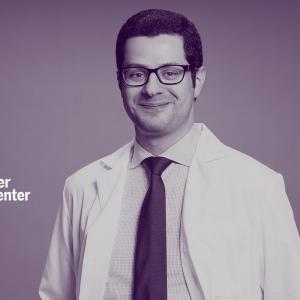
Marguerite Durkin got her life back on track after a blood and marrow transplant from donor Florian.
Photo: NYU Langone staff
It was October 2017 when Marguerite Durkin noticed she was having shortness of breath and difficulty taking long walks—something she had always enjoyed doing. She also noticed unexplainable black-and-blue bruises on her body. Durkin, 71 years old and a retired teacher living in Floral Park, New York, dismissed her symptoms as signs of aging and due to her sensitive skin. But as the weeks progressed, she instinctively knew something was not right.
Eventually, Durkin went to an urgent care clinic, where the doctor ordered a series of blood tests. The next morning, the doctor’s office called and advised her to pack a bag and go to the hospital because her blood platelets and red and white blood cell levels were alarmingly low. She immediately traveled by ambulance to NYU Langone Hospital—Long Island, where she was placed under the care of hematologist Robert S. Weiner, MD.
Durkin remained in the hospital for five days and received transfusions until her blood and platelet levels stabilized. During that time, she says, “Dr. Weiner was absolutely wonderful—he was accessible and made it a priority to figure out what was wrong with me.”
Seeking a Diagnosis
For the next few months, Durkin made many trips to the Infusion Center for regular blood transfusions and platelets. Her blood cell levels went up temporarily, but she was still dependent on transfusions, and at times, she developed allergic reactions. In June 2018, Dr. Weiner referred Durkin to Samer Al-Homsi, MD, MBA, a hematologist and director of the Blood and Marrow Transplant Program at NYU Langone’s Perlmutter Cancer Center. The program is certified by the Foundation for the Accreditation of Cellular Therapy (FACT), which is a testament to the team’s commitment to patient safety and delivering the highest levels of care.
“I felt reassured right from the first time I met Dr. Al-Homsi. He continues to make me smile,” says Durkin. Dr. Al-Homsi ordered blood tests and a bone marrow biopsy, and determined that she had myelodysplastic syndrome, a group of cancers in which immature blood cells in the bone marrow do not mature or become healthy blood cells. Myelodysplastic syndrome often leads to fatigue, susceptibility to infections, and uncontrolled bleeding. In December 2018, after a few rounds of targeted therapy did not work as desired for Durkin, Dr. Al-Homsi suggested a blood and marrow transplant, in which Durkin would receive new blood-forming stem cells to replace her existing ones. She immediately said yes.
“Marguerite was at risk of developing leukemia and did not want to spend the rest of her life dependent on transfusions. A blood and marrow transplant seemed like the best option, despite her age. She understood the risks and what she wanted to achieve, and trusted in me and my team,” says Dr. Al-Homsi.
Finding a Bone Marrow Donor
Dr. Al-Homsi initiated the process of finding Durkin a stem cell donor through the National Marrow Donor Program, a national registry that helps people with leukemia, lymphoma, and other diseases find a matched donor. The registry’s software compares a patient’s tissue type with those in its database of millions of potential volunteer donors worldwide.
Durkin’s chances of finding a donor were better than average—the search can be far more difficult for people of other ethnic backgrounds. One of the goals of Perlmutter Cancer Center’s Blood and Marrow Transplant Program team is to make sure every patient who needs a blood and marrow transplant has a donor. This means improving the outcomes of transplants from half-matched or haploidentical donors, who are usually a patient’s mother, father, or child.
Durkin had another challenge: her age. Few transplant centers perform transplants in older patients. Dr. Al-Homsi and his team, armed with experience and impeccable supportive care, did not shy away from such procedures. Durkin had a thorough physical exam and other tests to confirm that she was an appropriate candidate for the transplant. She also met with a social worker and financial counselor from Perlmutter Cancer Center, who helped her navigate the logistics and insurance approvals involved. By the beginning of January 2019, Dr. Al-Homsi had good news to share: A fully matched donor had been found. As Durkin later learned, he was living in Bavaria, Germany.
VIDEO: Marguerite Durkin was at high risk for developing leukemia, and Dr. Samer Al-Homsi and the Blood and Marrow Transplant Program team performed a lifesaving stem cell transplant that not only allowed her to thrive but also meet her donor nearly three years later.
This set into motion a process that Dr. Al-Homsi calls “a chain of love.” After a potential match is found for a patient, Dr. Al-Homsi and his team partner with the National Marrow Donor Program and local healthcare facilities to provide the donor with a thorough physical exam, medical history evaluation, and blood tests. When the donor is determined to be appropriate, the patient gets admitted to the hospital and receives an initial conditioning regimen to prepare the body and bone marrow for the transplant.
“A lot of coordination is involved to collect and deliver the donor’s cells, especially when the donor lives abroad. When we receive the donated cells, we have to be ready to infuse them the same day into the patient,” explains Dr. Al-Homsi.
Durkin was admitted to a private room in the hospital on January 30, 2019, a day before her 73rd birthday. The room was equipped with specialized air-filtering systems to protect her immune system, which can be considerably weakened following a blood and marrow transplant. On her birthday, she recalls, nurse Nicole Karich walked into her hospital room with a champagne bottle filled with chocolate. Cheryl Martinez, Dr. Al-Homsi’s nurse practitioner, arranged for a cupcake with a birthday greeting. “It’s one thing to get medical treatment that is excellent. But it’s another thing when people go above and beyond. They took care of me not just physically but also emotionally and spiritually,” says Durkin.
“It’s one thing to get medical treatment that is excellent. But it’s another thing when people go above and beyond. They took care of me not just physically but also emotionally and spiritually.”—Marguerite Durkin
Durkin remembers the names of many of the nurse and staff members who cared for her during her stay in the hospital. She describes the care she received as seamless and flawless—“like watching a well-choreographed ballet.” The dance analogy is apt, as Durkin says she loved to put on music and dance in her hospital room to keep her spirits up and stay physically active.
On February 6, after five days of chemotherapy, followed by a day of radiation therapy, Durkin received the lifesaving transplant, in which the donor’s cells were infused into her veins. She was monitored carefully to make sure she did not develop complications, especially graft-versus-host disease, in which immune cells in donated blood and marrow attack the tissues of a recipient.
Coming Home
After three weeks in the hospital, Durkin was cleared by Dr. Al-Homsi and team to return home, with a detailed list of precautions and lifestyle changes she needed to make to limit her exposure to infections. For instance, she always wore a mask when she went out in a public place. She began to lose her hair in clumps, and had her beautician come over and shave it off. An NYU Langone nutritionist advised her on creating a balanced diet plan.
For the first six months, Dr. Al-Homsi and team followed up with her regularly, monitoring her blood work and medications and looking closely for any signs of complications or infections. “Dr. Al-Homsi’s nurse would call me even on weekends to check up on me, making sure I was doing what I needed to do after the transplant. They were always available to answer questions,” says Durkin.
Exactly a year later, Durkin visited Dr. Al-Homsi’s office for a follow-up appointment, carrying with her a list of all the things she wanted to do: go on a cruise, see a Broadway show, watch a movie in the theater, and take a vacation to Puerto Vallarta, Mexico. “Dr. Al-Homsi said yes to everything. But unfortunately, soon after, the COVID pandemic hit,” she laughs.
Four years later, Durkin is thriving and continuing to enjoy the things she loves doing—socializing with friends, traveling, and meeting with former students. Life also came full circle for her when she was finally able to meet her donor, Florian, a volunteer firefighter who traveled from Germany to spend time with her in August 2022. “My donor is such a special person—I hope that by getting his stem cells and DNA, I’ve inherited some of his goodness,” says Durkin.
For anyone else going through the complexities of a blood and marrow transplant, Durkin has these words of advice: “Don’t give up hope. Find the right medical team to take care of you, be patient, and when the time is right, dance like no one is watching.”

